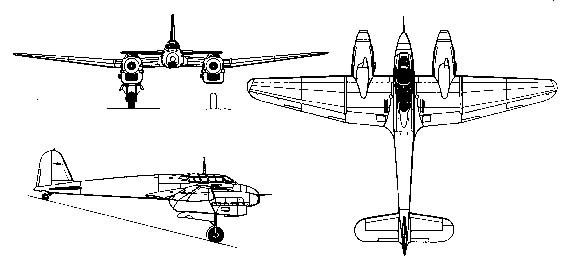LUFTWAFFE RESOURCE CENTER > FIGHTERS/DESTROYERS > PREVIOUS PAGE
Focke Wulf Fw 187

Type: Two-seat destroyer
Origin: Focke Wulf Glugzeugbau GmbH
First Flight: Early May 1939, A-0 in February 1939
POWERPLANT:
Model: Junkers Jumo 210Ga
Type: 12-cylinder liquid-cooled engines
Horsepower:
700hp at take-off
730hp at 1,000m (3,280 ft.)
Number: Two
DIMENSIONS:
Wing span: 15.30m (50 ft. 2.5 in.)
Length: 11.12m (36 ft. 6 in.)
Height: 3.85m (12 ft 7 in.)
Wing Surface Area: 327.22 Sq. Ft.
|
|
WEIGHTS:
Empty: 3,700kg (8,157 lbs.)
Maximum: 5,000kg (11,023 lbs.)
PERFORMANCE: Normal, Loaded
Maximum Speed:
322 mph (518 kph) at sea level
329 mph (529 kph) at 13,780 ft (4,200m)
Initial climb: 3,445 ft/m (1050 m/m)
Time to 6,560 ft (2,000m): 1.9 minutes
Time to 19,685 ft (6,000m): 5.8 minutes
Service Ceiling: 32,810 ft. (10,000m)
ARMAMENT:
Two 20mm MG FF Cannon in lower fuselage
Four 7.9mm Mg 17 Machine Guns in fuselage sides
|
Developed by Kurt Tank in the mid-1930s, the Falcon was intended to compete against the Messerschmidt Bf 110. Originally intended to be powered by Daimler-Benz 600 series engines, the Falcon was nearly crippled by the RLM's requirement that the Junkers Jumo 210 series be used. Even so, during flight trials the Falcon showed itself to be 50 mph faster than the Bf 109B. Climb and Dive rates matched or exceeded the much-vaunted single-engine fighter with the Fw 187 being nearly twice the weight of the Messerschmidt fighter.
The Fw 187's initial role was to be a fast interceptor, however, requirements from the powers that be dictated that the Falcon be a destroyer. This dictated that a second crewman be added, this not occuring until the third prototype was built. Chronically underpowered, the addition of the second crewman as well as several other dictated changes caused the Falcon's performance began to suffer. Additionally, the Fw 187 did not mount a rear gun. This destroyer requirement doomed the Fw 187 and the RLM stuck with the Bf 110.
The three production Falcons were used by Fock Wulf in thier factory defense squadrons, flown by test pilots, until Winter 1940 when they were sent to Norway. There they were unofficially evaluated by service pilots who preferred them to thier current Bf 110's. In 1943 the Fw 187 was considered for the night fighter role, but it's narrow fuselage did not allow the fitting of the necessary radar and equipment. Regardless, by this time Focke Wulf was engrossed with the development of the
Ta 154 and the concept was shelved.
We will never know the true potential of the Fw 187. It's major problems were more political than technological. Obviously better than the Bf 110 in it's various roles, who can say what the outcome of the Battle of Britain would have been if DB 600 equipped Fw 187's had reached production.








Sources:
Gunston, Bill & Wood, Tony - Hitler's Luftwaffe , 1977, Salamander
Books Ltd., London
, 1977, Salamander
Books Ltd., London
The Complete Encyclodepia of World Aircraft, 1997, Barnes & Nobles
Books
Thanks to Richard Faulkner & Giancarlo Lupo for assisting in data clarification
Brown, Eric, Captain - Wings of the Luftwaffe , 1979, Airlife Publishing Ltd., Shrewsbury
, 1979, Airlife Publishing Ltd., Shrewsbury
LUFTWAFFE RESOURCE CENTER > FIGHTERS/DESTROYERS > PREVIOUS PAGE









